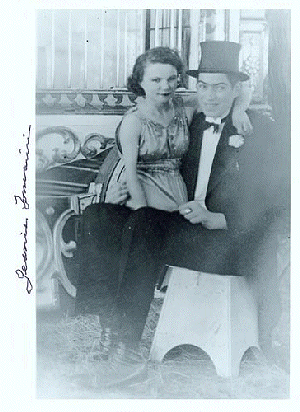Wedding photograph of Al and Jeanie Tomaini
glossy photograph, 10 x 8 inches, reprinted
circa 1997
autographed in ink by Jeanie Tomaini
photographer: unknown
Al Tomaini and Bernice "Jeanie" Smith
married in 1936 and toured for decades as "The World's Strangest
Married Couple" — which is quite a reasonable assertion when the groom
is a giant and the bride is "The World's Only Living Half-Girl".
The Tomaini's worked circuses and carnivals, and for a time owned and
managed their own shows.
Jeanie was born in Blufton, Indiana, on 23 August 1916. Although a healthy child, she was
born without legs. Realizing the money-making potential, her parents started Jeanie down
that sawdust trail while she was still an infant. Initially Jeanie worked the "pumpkin fairs" in Indiana, then started traveling
to neighboring Midwestern states — working all summer and attending
school in the fall (unless she had a booking). Jeanie always insisted
that she loved every minute of her performances, which consisted largely
of gymnastic feats such as handstands, cartwheels, and climbing a ladder. By the age of
eleven, Jeanie moved up from being a "single-o" at local agricultural
fairs to playing with some of the larger organized carnival and circus
outfits.
During the mid 1930's, Jeanie met her future husband Al Tomaini
(8-feet 4.5-inches tall, born 25 February 1912 in Long Branch, New Jersey)
on one of the shows. While Jeanie had been a trouper almost
since birth and enjoyed the work, Al — at this time about twenty-two
years old and taking medication to retard his growth — was fairly new
to the game and wasn't entirely comfortable with being stared at. Jeanie
sensed Al's loneliness and befriended him, and a romance soon began to
blossom. Friends and promoters had been pestering them to get married
in front of a crowd, but Jeanie and Al wanted a private ceremony. So,
one night while working a fair in Cleveland, Ohio, the couple eloped and
were married by a justice of the peace in New York state. Like many newlyweds,
the couple honeymooned in Niagara Falls.
By 1949, the Tomaini's had largely left life on the road behind them, though they
would occasionally make special guest appearances. They lived comfortably with
their adopted children in Gibsonton, Florida, where Al served as both police and
fire chief for many years.
Unfortunately, the glandular condition that caused Al's gigantism also doomed
him to an early death. Al passed away at the age of fifty on 30 August 1962.
Jeanie outlived her husband by many decades but died on 10 August 1999 — which was, remarkably,
the fifty-third anniversary of the day she received her daughter, Judy,
and just two weeks shy of her own eighty-third birthday.

Original bumper sticker for the Giant's Fishing Camp
Day Glo ink silk-screened onto heavy paper, 4.25 x 18 inches,
circa 1955
printed by Serigraph Corp., Miami, Florida
During the late 1930's, the Tomaini's vacationed in Florida
at a trailer campsite on the banks of the Alafia River. Many of
the their show friends also came down to rest their heels and enjoy
the fishing. Eventually, Al and Jeanie purchased a piece of land on
the other side of the river, which they cleared with the help of friends
and turned into The Giant's Fishing Camp.
In an e-conversation with Al and Jeanie's daughter, Judy (a.k.a., Rustie Rock), she
told me that the name the property still bears today was suggested by visiting friend
Frank Lentini, the Three-legged Man (see my tribute to Frank, Francesco Lentini as a
Lutenist,
here, or read his pitchbook
here). Judy wrote:
[Frank Lentini] stopped in, when they first bought the property,
and as they had carny friends that came and parked their trailers so
they could go fishing, the first thing built was the bait shop, since
fishing was what brought them here to begin with. The next time Frank
came through, he was surprised to see how much had been done on the trailer
park and bait house. Also by then, a few of the front five cottages had
also been built. He asked my Dad what he was going to call the place, and
he said he hadn't even thought of calling it anything other than "Home"
(which the family still calls it, and it has been home to many people).
So Frank said, "Why not call it the Giant's Camp?" He did, and the rest is
history.
In the mid 1950's, Al Tomaini had the bumper sticker above
printed to advertise The Giant's Fishing Camp in Gibsonton, "The Town
You Read about in the Sat. Eve. Post".
While visiting sideshow historian James Taylor at his American Dime Museum
(with which he is no longer involved) in Baltimore one day, James told me how
Al had these made up and started proudly handing them around, applying them to bumpers
all over town, etc. Everything seemed fine — until the first rainstorm
proved the bumper stickers were not weather-proof, and the newfangled
ink washed right off. As James tells it, furious oaths were uttered,
and all the remaining bumper stickers were packed away in the attic over
the garage, where they remained for forty-odd years.
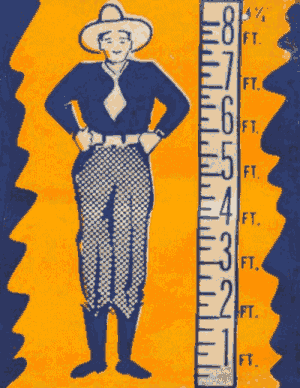
[for more information about Al and Jeanie Tomaini, see James Taylor's interview
"I Dream of Jeanie" in James
Taylor's Shocked and Amazed! On & Off the Midway,
Guilford: The Lyons Press, 2002; another invaluable source
is Judy Tomaini Rock's
series of stories about her parents, published
on SideshowWorld.com.]

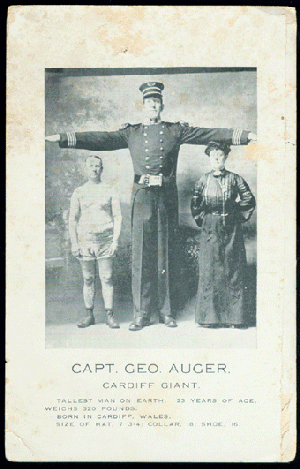
Capt. George Auger, Cardiff Giant
cabinet card, 6.5 x 4 inches, circa 1910
photographer: unknown
George Auger worked for Barnum & Bailey from 1906 until shortly
before his death in 1922. On this card, Auger appears in military uniform
with his arms extended over the heads of two normal-sized people, one
of whom appears to be a tattooed man. The text on the face of the card
reads:
CAPT. GEO. AUGER,
CARDIFF GIANT.
TALLEST MAN ON EARTH. 23 YEARS OF AGE.
WEIGHS 320 POUNDS.
BORN IN CARDIFF, WALES.
SIZE OF HAT, 7 3-4; COLLAR, 18; SHOE, 16.
Curiously, the name 'Cardiff Giant' has an American sideshow history that predates Mr. Auger.
In August of 1869, a large 'petrified giant' was 'discovered' on the small farm belonging to
William Newell in Cardiff, New York. The giant was found by a crew of workmen digging a new
well at a location precisely specified by Newell. Word of this exciting find spread quickly,
and soon there was a tent erected over the 'grave' and eager patrons flocking to see it, paying
50-cents each for the privilege. Within ten days, a syndicate headed by banker David Hannum
bought controlling interest in this ancient specimen and moved it to an exhibition hall in
Syracuse. A newspaper article brought national prominence and even larger crowds who were now
willing to pay a dollar each to peek at the giant.
Phineas Taylor Barnum heard of the Cardiff Giant's financial success and attempted to buy it
for his museum at a price of $50,000. Hannum wouldn't budge, so rather than increase his offer
Barnum had a plaster replica of the Cardiff Giant crafted and displayed it in his museum,
claiming that Hannum's giant was a fraud and that Barnum owned the true Cardiff Giant. The
replica of the hoax was soon outpacing the original in drawing power. Apparently believing his
giant was genuine, Hannum sued Barnum for slander. It was an exasperated
Hannum — not Barnum — who uttered the often misquoted phrase, "There's a
sucker born every minute."
During the trial, George Hull stepped forward and revealed that he had masterminded this fraud
years earlier by hiring stonemasons in Chicago to craft the Cardiff Giant from a large block of
gypsum. The masons worked in absolute secrecy, carving in their spare time in a secluded barn.
The sculpture was given the patina of age through the liberal use of darning needles, ink, water
and sulfuric acid. Hull shipped the finished product to his cousin William Newell's farm and
secretly buried it under cover of darkness beside the barn with the help of Newell and his sons
in anticipation of its eventual 'discovery' the following year. This was precipitated by an
important fossil find nearby. The timing was right, so Hull signalled his cousin to have the
giant unearthed.
The judge dismissed Hannum's slander claim, ruling that Barnum had been absolutely correct in
describing Hannum's giant as a fraud.
So, it may be that George Auger — whether from the original Cardiff in Wales or not — took
a name hearkening back to the earlier giant in his own presentation. One thing is certain:
Auger's height was no fraud.
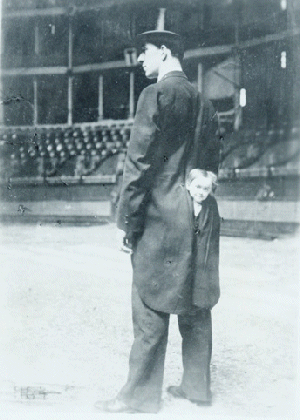
Giant George Auger and Midget Tom Sordie
glossy photograph from Kobel collection, 7
x 5 inches, printed circa 1950
This scene features Welsh giant George
Auger (8-feet 6-inches tall), with Tom Sordie (29-inches tall)
poking his head out through the tails of Auger's coat. How exactly
Sordie has suspended himself under Auger's coat I'm not quite sure,
nor can I explain why he would want to do so. The original photo
was probably taken about 1916, when both worked for Barnum & Bailey.

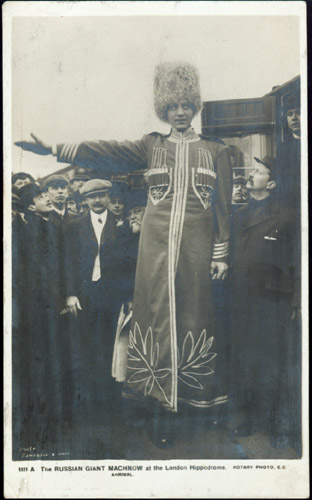
The Russian Giant Machnow at the London Hippodrome
real photograph postcard, 5.5 x 3.25 inches, 1905
photographer: Campbell & Gray
Yet another exotic foreign attraction was the Russian Machnow, who in his elaborate long coat
(very slimming) and his tall furry hat towered above puny Englishmen, as is evident in this
photograph depicting his arrival in London in 1905.
Machnow appeared with several circuses, affecting a sort of nutcracker-like persona. As was the
custom, he was often to be seen in the company of midgets.


Mr. and Mrs. Fischer
linen postcard, 5.5 x 3.5 inches, circa 1940
Gottlieb "Fred" Fischer (8-feet 1-inch) was born in Vienna, Austria, and his
bride Elfriede (7-feet 11-inches) hailed from Bernstadt, Germany — which makes
their outrageous 'wild west' cowboy costumes all the more bizarre.
Gottlieb and Elfriede met when both were booked in a London dance revue. A romance bloomed, followed by a wedding in November 1933.
In 1937 the giant couple made their way to America, where they were initially billed as Mr. & Mrs. Long on the
Hagenbeck-Wallace and Cole Brothers circuses. When picked up by Ringling Brothers, they resumed their actual names and
affected western attire.
The Fischer's retired from show business in 1948 to run a motel near
Sarasota, Florida.
The text on the front of this card reads:
GREETINGS FROM THE BIGGEST COUPLE
MR. & MRS. FISCHER
WITH THE GREATEST SHOW ON EARTH
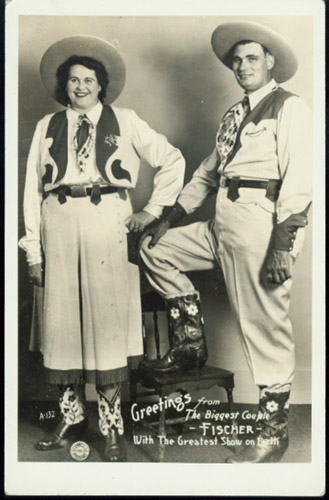
The Biggest Couple — Fischer
real photograph postcard, 5.5 x 3.5 inches, circa 1940
photographer: Campbell's Photo Art, Dayton, Ohio
This photograph clearly served as the model for the more colorful version above. The caption is just slightly different: "Greetings from The Biggest Couple — FISCHER — With The Greatest Show on Earth".

 Ring of Jack Earle, Texas Giant
Ring of Jack Earle, Texas Giant
pot metal cast ring, approximately 1.25 inches in diameter, circa 1930
Jack Earle, the Texas Giant, was born Jacob Ehrlich in Denver, Colorado. When he began appearing
in silent films he adopted the name 'Jack Earle' as his stage persona. Claiming a height of 8-feet 6.5-inches,
Earle worked as a giant in various circuses from 1926 to 1940, usually appearing
in cowboy duds. Additionally, he was alleged (in a publicity still from the late 'twenties) to be a deputy sheriff
for El Paso, Texas.
Like many sideshow giants, Jack Earle supplemented his income by selling a giant ring,
reportedly sized to fit his hand. I cannot say whether this is true in Earle's case, but it
should be noted many giants offered rings that considerably exaggerated the size of their
finger.
This ring is a bit more ornate than most, with a low-relief decoration of roses on the band.
The face of the ring says "JACK EARLE — 8 FT 6 1/2 — GIANT".
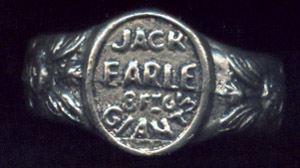

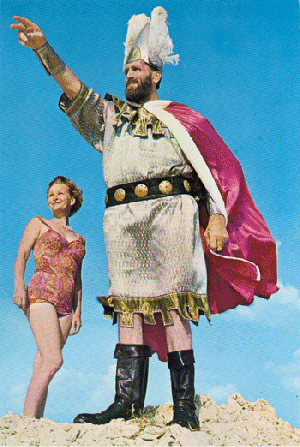
Johann K. Petursson, The Tallest Man in the World
over-sized postcard, 9 x 6 inches, circa 1960
photographer: unknown
Johann Petursson was billed as "the Icelandic Giant" and claimed a height of nearly nine
feet, though he was probably closer to seven. Early in his career he dressed the part of
the dandy in top hat, waistcoat and tails — but in later years he took to wearing
the outlandish Viking costume pictured here.
Petursson was born in Dalvik, Iceland in 1913. He began exhibiting himself in Europe, and
spent the duration of the second World War trapped in Copenhagen, Denmark. In 1948, Petursson emigrated to America, where he initially appeared
with Ringling Brothers. In 1950, Johann appeared in a campy B-movie called Prehistoric Women.
At some point during the 1960's Petursson retired to Gibsonton, Florida, but showman (and
neighbor) Ward Hall was able to coax him to work for him one last time in 1973 for a Smithsonian
event in Washington, D.C. Petursson passed away in 1984 — having achieved quite a respectable
age for a giant.
This postcard, large like the man himself, depicts Johann in his Viking get-up, where he towers
over the normal-sized woman standing well behind him and downhill (subtle, eh?). The reverse of
the card bears an inscription that says:
JOHANN K. PETURSSON
Tallest man in the world
Born 1913 — In Iceland
Parents, 8 Sisters and Brothers all of normal size. My weight — 9 lbs. at birth.
By the age of twenty I was 8'8". Weight — 425 lbs. Shoe size 24. All clothes made to order.
P.S. Except handkerchief.

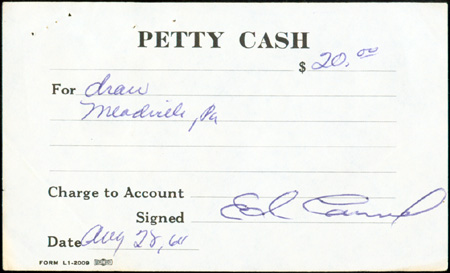
Petty Cash Receipt signed by Eddie Carmel
2.25 x 3.5 inches, 28 August 1964
signed in blue ink, "Ed Carmel"
Eddie Carmel (1936-1972) was known on the shows as the Happy Giant and the Jewish Giant. The later moniker is probably best
recognized from the iconographic Diane Arbus photograph, A Jewish giant at home with his parents in the Bronx, N.Y. 1970.
Carmel was born in Tel Aviv, Israel, and emigrated to the United States at the age of two. Although his parents were of average size, their
infant son's large size (16 pounds at birth) was likely genetic, as Eddie's maternal grandfather stood 7 feet 5 inches tall and was known as
the world's tallest rabbi (a category surprisingly overlooked in the record books). By the age of seventeen Eddie Carmel was well on his way to
meeting his grandfather's height. Midway through his business studies at City College, Carmel realized that his most likely vocation was
to be found exhibiting his massive frame. He dropped out of school to pursue a show career, which included a brief stint with a rock band called
Frankenstein and the Brain Surgeons. In 1962, Carmel was cast in the horror flick The Brain That Wouldn't Die. However, such parts were hard
to come by, so Carmel entered the sideshow circuit to supplement his income.
Carmel appeared with Milt Levine's World of Mirth and with Ringling Brothers during their annual Madison Square Garden gigs. He earned considerable amounts
of money as a feature attraction, but Eddie disliked the routine. Furthermore, by the late 1960's his acromegaly had worsened, and began to cause him great pain.
He was no longer able to climb the platform and stand for long periods of time, and so retired in 1969. Shortly afterwards Carmel was no longer able to walk.
His heart finally gave out on 30 July 1972.
This petty cash receipt represents Eddie Carmel's portion of the ticket sales from an appearance in
Meadville, Pennsylvania, on 28 August 1964.

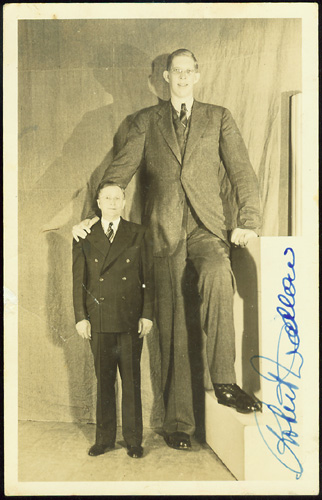
Robert Pershing Wadlow, World's Tallest Man
real photograph postcard, 5.5 x 3.5 inches, circa 1940
autographed in blue ink, "Robert Wadlow"
photographer: unknown
Robert Pershing Wadlow was not a freak in the conventional sense — that is, he never wished to
exhibit himself in the context of a circus or carnival sideshow. Wadlow's one brief stint in a circus role
was with Ringling Brothers for a season or two starting in 1937, but his contract stated he would
only appear in two three-minute shows a day at the annual Madison Square Garden and Boston Garden dates —
and only in center ring as part of the main show. He did, however, act as traveling mascot for the
International Shoe Company, who enthusiastically clad Robert's sizeable feet.
Robert Wadlow was born to Addie and Harold Wadlow in Alton, Illinois, on 22 February 1918.
Although he weighed a rather normal 8-pounds 6-ounces at birth, Robert's overactive pituitary
gland quickly accelerated his growth. By the age of six months, Robert already weighed in at
30 pounds, and was a hefty 42 pounds by the time he started to walk. This astonishing rate of
growth continued unhindered, and by the age of eight Robert was already 6 feet 2 inches tall.
Of course, Robert's size attracted considerable interest. Local and national papers followed
his developments and cameras were on hand when Robert, at 13-years-old and 7-feet 4-inches tall,
achieved the title of "World's Tallest Boy Scout". Shortly after, the media documented his entry
into the Masonic youth organization DeMolay and then the Freemasons (where one assumes he also
holds the respective records). Robert officially became the world's tallest man in 1937, when at the
height of 8-feet 4-inches he surpassed the height of the Irish giant O'Brien (a.k.a., Charles Byrne), who died in 1783.
By the age of 20, Robert's specially made shoes cost approximately $100 a pair, which was quite
a considerable sum for the 1930's. The International Shoe Company began to provide his shoes
free of charge, and Robert became the company's traveling ambassador, visiting eight hundred towns in forty-one
states. Robert's father, who would act as chauffeur, modified the family sedan by removing the
front passenger seat so that Robert could sit in the back and stretch his long legs. Together,
Robert and his father traveled over 300,000 miles in three years on behalf of International
Shoes.
One consequence of Robert's size was that he had very little feeling in his feet. Often, he was
unaware of problems until blisters had already formed. While appearing in Manistee, Michigan,
in July 1940, Robert developed blood poisoning from an infected blister on his foot. On 4 July,
doctors confined Wadlow to the bed in his hotel room because no local hospital was able to
accommodate him. Robert Wadlow died at 1:30 A.M. on 15 July 1940. Ironically, the man who traveled
on behalf of a shoe company was done in by an ill-fitting shoe.
Robert's body was returned to his hometown for burial. At the time of his death, Robert Wadlow, The Alton Giant, was
8-feet 11.1-inches tall and weighed 490 pounds. His 1,000-pound coffin required a dozen
pallbearers assisted by eight more men. Tens of thousands attended his funeral.
The reverse of this card was inscribed as follows by someone who attended one of Robert Wadlow's
shoe promotions:
I seen Robert in Purcell.
Age 22 — weight 491
Height 8 feet 9 inches
Weight at birth 8 1/2 lb.
Weight at 6 mo 30lb
Weight at 18 mo 62lb
Weight at 9 years 180
Height at 9 years 6ft 1in.
Size of shoe 37A
Died 1 month later from blood poison
|

